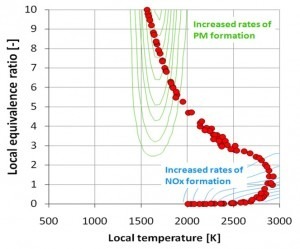In-Cylinder Equivalence Ratio & Temperature Evolution
The engine in-cylinder mixture is represented by using a Probability Density Function (PDF) method. This function is made up of representative multiple air-fuel parcels or more precisely if using the mathematical definition – stochastic particles. One extreme is to use a single particle which is analogous to a single zone model. However modern IC engines are highly stratified (in terms of temperature and fuel stratification). Thus, in order to simulate combustion and emissions more robustly we must consider inhomogeneity stratification to carry out a more detailed analysis.
In the same way as with 3D CFD, as you increase the amount of refinement used to represent the in-cylinder mixture, you reach a convergence in your solution. However, unlike the number of cells that are usually required to reach convergence in 3D CFD (10,000s), using 100 stochastic particles has proven enough for the hundreds of IC engine applications simulated with SRM Engine Suite. Therefore, we can speed up the CPU time by a large order of magnitude for equivalent performance while achieving better emissions prediction as the stochastics particles contain detailed physico-chemical information.
To demonstrate the application of the SRM Engine Suite for different IC engine applications, we present an animation of each operating mode below. Each animation presents the evolution of the PDF as a function of time over local in-cylinder temperature and equivalence ratio. Each simulation was carried out at the same speed-load point with a summary of the operating condition presented in the table below.
In each case a compression, heat transfer, turbulent mixing and injection event is simulated followed by fuel oxidation and emissions formation via the solution of a user defined chemical kinetic sub-model. Each mark represents the local composition for each stochastic particle. As might be expected, the PDF for each operating mode has evolves differently – for example the CIDI operating mode has regions of the mixture which are ultra-rich (φ>3.0) ultimately leading to higher PM formation rates.

Particle Animations
The following particle animations were generated using the SRM Engine Suite for a variety of fuels and engine operating conditions (all operating at 1500 RPM, 2.6 BMEP, 30% EGR). These visualisations are a unique feature of the SRM Engine Suite, which offers the user a measure of the inhomogeneity (temperature and composition) in the cylinder and helps identify sources of soot, NOx, etc. in the engine
| Operating Mode | DISI | HCCI | CIDI |
| SOI [aTDC] | -100 | -100 | -2 |
| EOI [aTDC] | -90 | -90 | 25 |
| Compression Ratio | 11 | 15 | 15 |
| PBoost [bar] | 0.75 | 1.2 | 1.2 |
| Fuel | Gasoline | Diesel | Diesel |
| Animation |
